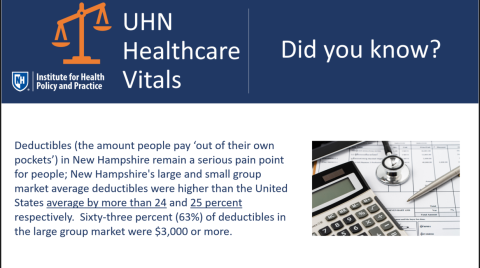UNH Healthcare Vitals: New Hampshire Insurance Department’s Annual Hearing on Health Care Premiums and Claim Cost Drivers

Did you know?
Late this fall, the New Hampshire Insurance Department (NHID) held its Annual Hearing on Health Care Premium and Claim Cost Drivers. It released its preliminary annual report on New Hampshire’s commercial health insurance market premiums and deductible trends and factors that have contributed to any changes over the years. NHID’s report reflected that premiums increased again this year and New Hampshire continues to have some of the highest deductibles in the region and in the country. For the first time, there was a panel on health system costs, hospital consolidations, and cost transparency discussing direct impact that rising health system costs have on premiums and deductibles."
Here is the latest:
According to the NHID report, the majority of the New Hampshire population (61%) have private health insurance - with 54% having employer-sponsored insurance and another 6-7% purchasing individual plans. Deductibles (the amount people pay ‘out of their own pockets’) remain a serious pain point for people; New Hampshire's large and small group market average deductibles were higher than the United States average by more than 24 and 25 percent respectively. Sixty-three percent (63%) of deductibles in the large group market were $3,000 or more. The prices of insurance premiums continue to rise; the overall average fully-insured premium PMPM in New Hampshire increased 3.2 percent in 2022, reflecting increases in small and large group market premiums of 3.4 percent and 5.1 percent respectively, and an increase in individual market premiums of 1.3 percent.
After the formal presentation of the annual report, NHID hosted a panel on the topic of healthcare consolidation and healthcare price transparency. The panel explored the growing problem of health system prices, how healthcare cost transparency and healthcare consolidation can impact prices as well as policy tools states can deploy around these issues.
Zach Brown, an Economics Professor at the University of Michigan, affirmed that healthcare price transparency through New Hampshire’s healthcost website puts downward pressure on prices, but noted price shopping is mostly done by those with high deductible health plans, and
these individuals may not have real options for lower cost care nor the power to successfully pressure prices across the larger system..
The RAND Hospital Price Transparency Project, led by Christopher Whaley, which aims to support hospital price transparency for employers, indicated healthcare prices are primarily driven by consolidation of hospital markets and specialty physician markets. The National Academy for State Health Policy (NASHP) speaker, Maureen Hensley Quinn echoed this conclusion, stating rising healthcare costs result from horizontal and vertical consolidation. NASHP highlighted state policy prescriptions that address healthcare market oversight, anti-competitive contracting, and facility fees as tools to address these trends.
The panel concluded that employers and patients have been left out of the discussion and that in order to truly influence price, there needs to be stronger regulatory oversight.
What does this mean for New Hampshire?
In recent years, New Hampshire has seen numerous consolidation transactions among healthcare entities. In October there were press reports of yet another a potential merger, this time between Catholic Medical Center and HCA . Continued healthcare consolidations come at a time in which more than a hundred thousand New Hampshire residents have medical debt in collections and premiums continue to rise.
New Hampshire’s leadership in healthcare cost transparency could be extended by exploring policy tools that use transparency to foster accountability, oversight, competition, and affordability to mitigate these trends.
